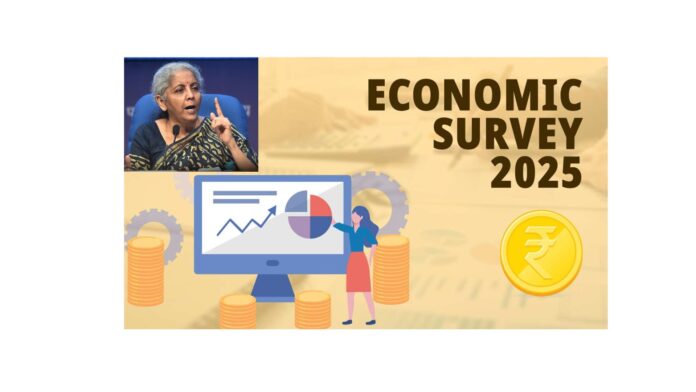The Economic Survey of India 2024-25, presented on January 31, 2025, provides an in-depth assessment of the country’s economic performance and forecasts for the upcoming fiscal year. Despite global uncertainties, the survey highlights India’s economic resilience, supported by strong policy initiatives and structural reforms.
India’s economy is poised for steady growth, with real GDP expected to expand between 6.3% and 6.8% in the financial year 2025-26 (FY26), according to the Economic Survey 2024-25 presented by Union Finance Minister Nirmala Sitharaman in Parliament. The survey estimates a real GDP growth of 6.4% for FY25, aligning closely with the nation’s decadal average.
Key Economic Indicators:
- Real Gross Value Added (GVA): Estimated to grow by 6.4% in FY25.
- Capital Expenditure (Capex): Grew by 8.2% between July and November 2024 and is expected to accelerate further.
- Retail Inflation: Softened to 4.9% during April-December 2024, with consumer price inflation projected to stabilize at around 4% in FY26.
- Exports: Overall exports grew by 6.0% (YoY) during April-December 2024, while services exports surged by 12.8% during April-November FY25, compared to 5.7% in FY24.
- Foreign Direct Investment (FDI): Gross FDI inflows increased from $47.2 billion in the first eight months of FY24 to $55.6 billion in FY25, a year-on-year (YoY) growth of 17.9%.
- Forex Reserves: Stood at $640.3 billion at the end of December 2024, covering 10.9 months of imports and approximately 90% of external debt.
Sectoral Highlights
- Agriculture: Expected to grow at 3.8% in FY25, driven by horticulture, livestock, and fisheries. Kharif foodgrain production is projected at 1,647.05 lakh metric tonnes (LMT), up by 89.37 LMT from the previous year.
- Industry: The industrial sector is estimated to expand by 6.2% in FY25, supported by robust construction and utility services.
- Stock Market: The Bombay Stock Exchange (BSE) market capitalization-to-GDP ratio stood at 136% by December 2024, significantly higher than China (65%) and Brazil (37%).
- Infrastructure: Solar and wind power capacity additions increased by 15.8% YoY in December 2024. Government plans sustained infrastructure investments over the next two decades.
Banking and Financial Stability
The Economic Survey highlights the resilience of India’s banking sector, marked by declining asset impairments, strong capital buffers, and improved operational performance. Gross non-performing assets (NPAs) have fallen to a 12-year low of 2.6% of total loans, while the capital-to-risk-weighted assets ratio (CRAR) for Scheduled Commercial Banks stood at 16.7% as of September 2024, well above regulatory requirements.
External Sector and Trade Performance
India’s external sector remains stable, supported by strong services trade and record remittances. Merchandise exports grew by 1.6% year-on-year in April–December 2024, while imports rose by 5.2%. The country has secured the seventh-largest share in global services exports, reflecting its competitive edge. Strong remittance inflows, driven by increased job opportunities in OECD nations, have helped contain the current account deficit (CAD) at 1.2% of GDP in Q2 FY25.
Foreign Investments and Forex Reserves
Foreign Direct Investment (FDI) inflows rebounded, growing 17.9% year-on-year in FY25. However, Foreign Portfolio Investment (FPI) flows remained volatile due to global geopolitical and monetary policy changes. As a result of stable capital flows, India’s foreign exchange reserves rose to USD 704.9 billion in September 2024 before moderating to USD 634.6 billion in January 2025. The reserves cover 90% of external debt and provide over ten months of import cover, safeguarding against external vulnerabilities.
Employment and AI-Driven Growth
The Economic Survey notes a steady decline in unemployment, from 6% in 2017-18 to 3.2% in 2023-24, supported by post-pandemic recovery and increased formalization. India’s youthful and adaptable workforce positions it well for AI-driven economic transformation. The report emphasizes the need for skill development and collaborative policymaking to ensure inclusive AI adoption in the labor market.
Infrastructure and Renewable Energy
A significant push for infrastructure investment is highlighted, with 2,031 km of railway network commissioned and 17 new Vande Bharat train pairs introduced in 2024. Port capacity improvements have reduced average container turnaround time from 48.1 hours in FY24 to 30.4 hours in FY25. The government’s focus on renewable energy through initiatives like PM-Surya Ghar, National Green Hydrogen Mission, and PM-KUSUM has resulted in a 15.8% year-on-year increase in renewable energy capacity.
Social Services and Economic Inclusion
Government expenditure on social services has grown at a compounded annual rate of 15% from FY21 to FY25. The declining Gini coefficient indicates a reduction in income inequality, particularly in rural and urban areas. The Survey underscores the government’s commitment to education reforms under the National Education Policy 2020 through various initiatives such as Samagra Shiksha Abhiyan and PM SHRI.
Healthcare and MSME Growth
The share of government health expenditure increased from 29% in FY15 to 48% in FY22, while out-of-pocket healthcare spending declined from 62.6% to 39.4% in the same period. The MSME sector continues to be a critical growth driver, with the Self-Reliant India Fund providing ₹50,000 crore in equity funding to support scalable enterprises.
Global Outlook & Future Prospects
The global economy grew by 3.3% in 2023, with the International Monetary Fund (IMF) projecting a modest 3.2% growth over the next five years. India’s economic trajectory remains strong despite global uncertainties, including geopolitical tensions and trade policy shifts. The survey highlights the importance of systemic deregulation, investment in human capital, and infrastructure expansion to sustain high growth rates.
As India aims for “Viksit Bharat” by 2047, the government is focused on reinforcing domestic economic drivers, promoting sustainable growth, and enhancing global competitiveness through grassroots-level reforms and policy enhancements.
India’s economic outlook remains positive, driven by strong domestic demand, infrastructure expansion, and strategic policy interventions. Despite global headwinds, the nation is on a stable growth path, with significant strides in agriculture, industry, exports, and fiscal management. Continued reforms and deregulation will be key to unlocking India’s full economic potential in the years to come.
Ease of Doing Business and Regulatory Reforms
The Economic Survey emphasizes the need to reduce regulatory burdens to enhance business efficiency and unlock growth potential. It outlines a three-step process for regulatory review and highlights the importance of state-led initiatives in the next phase of Ease of Doing Business (EoDB) 2.0, focusing on deregulation, enforcement safeguards, and risk-based regulation.
Commenting on Survey Anoop Rawat, Partner, Shardul Amarchand Mangaldas & Co. said:
While the Economic Survey has correctly noted that operational efficiencies are needed within IBC resolution, a few substantive legal issues also need to be resolved. For instance, the Supreme Court’s decision in State Tax Officer v. Rainbow Papers dilutes the policy underpinning the statutory waterfall under IBC. This legal position has detrimentally affected the risks and costs of secured credit transactions and also increased litigation. The government is expected to resolve this issue by explicitly excluding statutory first charge from the definition of ‘security interest’ under IBC.
Commenting on the survey Vijay Mani, Partner, Deloitte India said:
“The Economic Survey shows that the monthly average capital expenditure of the Union Government over July to November 2024 was 10% higher than that in Q1FY25. Thus, the pace of government capital expenditure is indeed picking up, which is an encouraging sign for the overall economy and for the financial services sector.”




